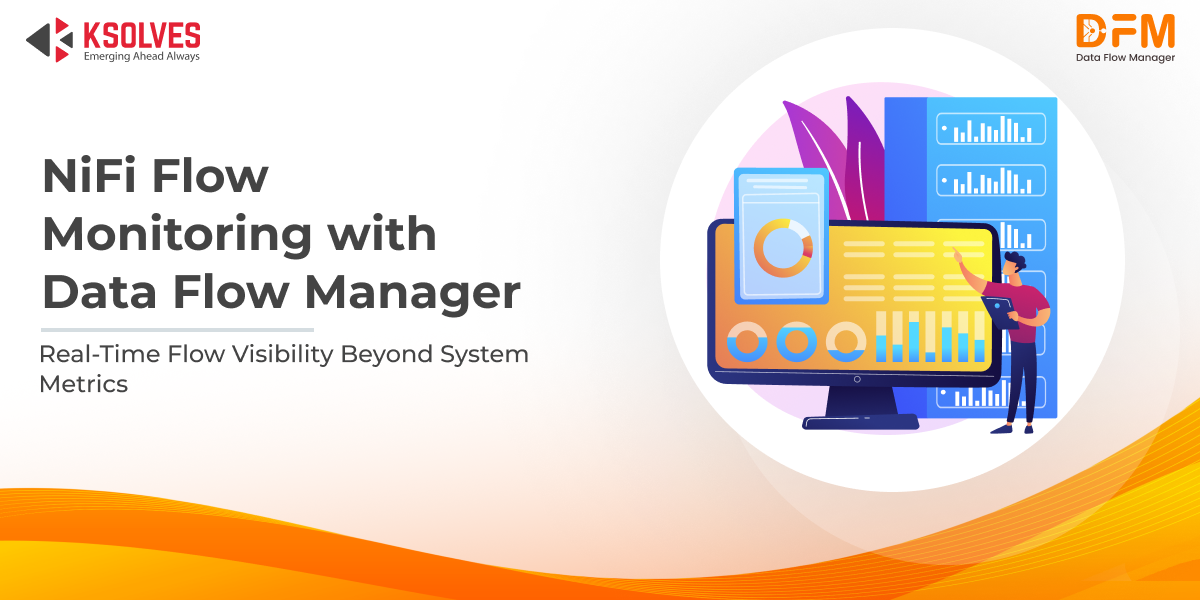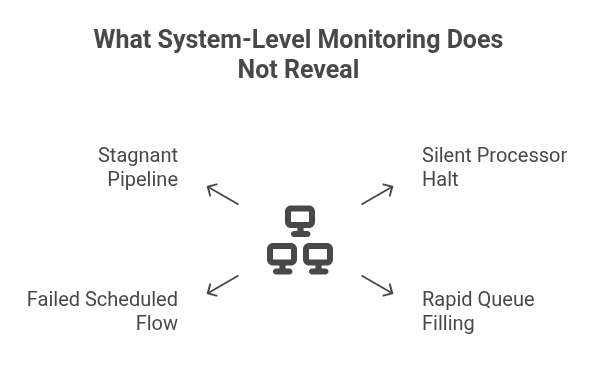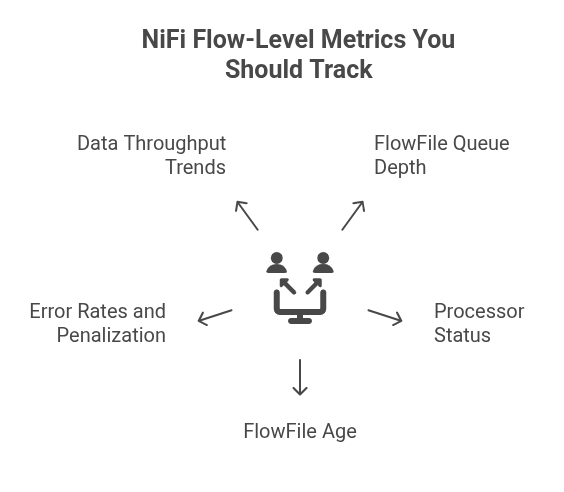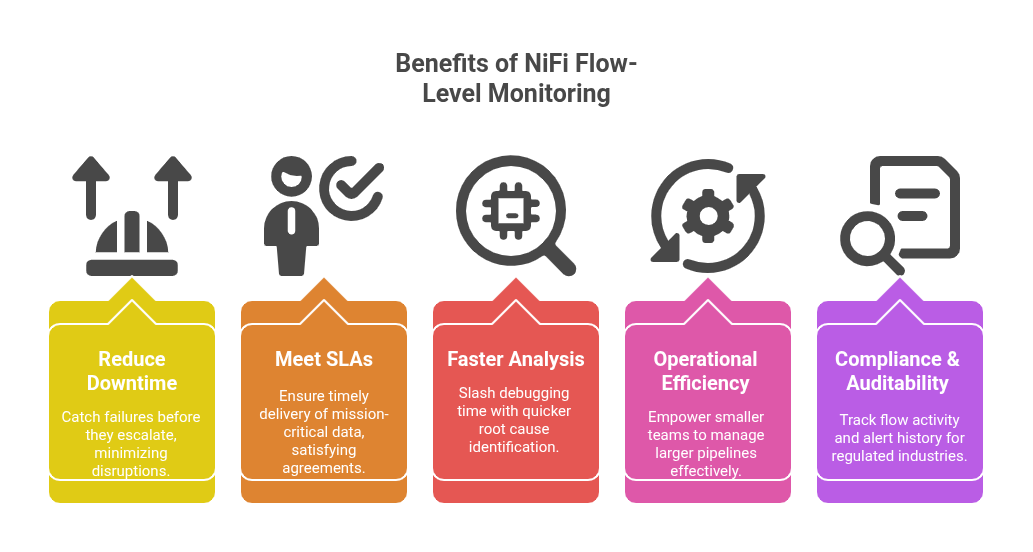Monitoring Apache NiFi Data Flows Like a Pro: Going Beyond Node Health
![]()

Apache NiFi has become a cornerstone for managing real-time data flows across enterprise systems. But as NiFi usage grows more complex, traditional system-level monitoring, focused solely on node health or JVM metrics, falls short of what’s truly needed. Organizations need granular visibility into flow-level performance to identify bottlenecks, diagnose issues, and ensure SLAs are met.
Flow-level monitoring is not just a technical enhancement but a strategic imperative for reliable, scalable data operations.
In this blog, we explore why system health alone is no longer enough, and how solutions like Data Flow Manager (DFM) are purpose-built to deliver deeper observability into NiFi data flows.
The Limitations of Traditional NiFi Monitoring
Tools like Prometheus, Grafana, and NiFi’s built-in system diagnostics provide valuable insights into infrastructure health. Their focus remains largely on the underlying system and not the data flows themselves. You can track metrics such as:
- CPU and memory usage
- Disk I/O throughput
- JVM performance indicators
- Node statuses (active, standby, disconnected)

These metrics are critical for keeping your NiFi cluster operational and for identifying node-level issues. However, they stop short of providing visibility into the behavior and performance of the actual data flows running across the system.
Here’s what infrastructure-level monitoring won’t reveal:
- A processor that has been silently stopped for hours.
- A rapidly filling queue caused by a downstream bottleneck.
- A scheduled flow that failed to trigger or complete on time.
- A pipeline that hasn’t processed any records since the last deployment.

Without this level of flow-specific visibility, operations teams are left blind to real issues that impact data integrity, SLA compliance, and business outcomes. Often, problems go unnoticed until they escalate, impacting users, breaking downstream analytics, or triggering costly delays.
Why Flow-Level Monitoring Matters
Apache NiFi flows are the backbone of your real-time data movement. They power critical processes like ingestion pipelines, ETL transformations, and streaming analytics across your organization. Monitoring the flow itself, not just the infrastructure, ensures your data operations are both resilient and accountable.
Here’s why flow-level visibility is essential:
- Pipeline Reliability: Instantly identify which flows are running smoothly, delayed, or have failed, ensuring operational continuity.
- Accelerated Troubleshooting: Pinpoint flow-specific issues without spending hours combing through node-level logs or system dashboards.
- Proactive Incident Response: Detect anomalies like halted processors or growing queues before they impact downstream systems.
- SLA Compliance: Stay ahead of business commitments tied to data timeliness, availability, and delivery expectations.
Real-World Scenarios
Scenario 1: A NiFi flow responsible for processing financial transaction data halts due to a misconfigured processor. Despite all nodes reporting healthy status, the system silently fails to process any transactions for hours. This leads to data loss and potential SLA violations.
Scenario 2: A downstream bottleneck causes a queue to back up, slowing data delivery to analytics platforms. Traditional monitoring tools miss the issue entirely, as they focus solely on CPU and memory metrics and not on flow congestion or processor states.
In both examples, infrastructure-level health appeared normal, but the data wasn’t moving, highlighting the critical need for flow-aware monitoring.
What True NiFi Observability Looks Like
Operating Apache NiFi at scale demands more than just system health checks. It requires deep, flow-aware observability – the ability to monitor, alert, and act based on what’s happening inside your data flows.
Key Flow-Level Metrics You Should Track
To truly understand the health of your NiFi pipelines, these flow-centric metrics are essential:
- FlowFile Queue Depth: Monitor how many FlowFiles are waiting in queues between processors. Sudden spikes can indicate downstream processing issues or stalled components.
- Processor Status (Running / Stopped / Invalid): Gain visibility into which processors are active, halted, or misconfigured.
- FlowFile Age: Track the oldest FlowFile in a queue to detect latency, stuck processors, or scheduling misconfigurations.
- Error Rates and Penalization: Identify processors repeatedly failing or penalizing FlowFiles due to bad input data or logic errors.
- Data Throughput Trends: Understand how data volumes are changing over time to detect anomalies or adjust scaling strategies.

Intelligent Alerting Should Include
While traditional tools may alert you about CPU spikes or JVM memory usage, operational resilience in NiFi comes from alerts like:
- Queue depth breaching thresholds: Suggests processing slowdowns or backpressure.
- Processors idle beyond a defined interval: Highlights stalled components or unexpected stops.
- Flows producing no output post-deployment: Detects potential misconfigurations or missed triggers.
- Spikes in FlowFile age: Flags bottlenecks or performance degradation.
How Data Flow Manager (DFM) Enables Proactive NiFi Monitoring
Data Flow Manager (DFM) solves one of the biggest gaps in NiFi operations: the lack of built-in, flow-aware monitoring. Designed specifically for NiFi environments, the tool empowers teams with deep visibility and operational control over their data flows.
Unified Dashboard with NiFi-Specific Metrics
Data Flow Manager captures and visualizes real-time flow metrics across your entire NiFi architecture. including individual processors, process groups, and entire clusters. Through a single dashboard, you can monitor:
- Processor States: Track how many processors are running, stopped, or in an invalid state.
- Queue Lengths: Identify growing queues before they become bottlenecks.
- Flow Health Across Environments: Gain a comprehensive view of processing status across development, staging, and production clusters.
This contextual view makes it easy to detect issues before they impact your data pipelines.
Intelligent Flow-Level Alerting
Unlike infrastructure-focused tools, Data Flow Manager’s alerting engine is designed around NiFi behavior. You can define and receive alerts based on flow-level conditions such as:
- Persistent Queue Backups: Trigger alerts if a queue remains uncleared beyond a defined window.
- Flow Failures or Unexpected Stops: Instantly detect when a flow fails to start or stops mid-execution.
- No Output Post-Deployment: Catch deployment misfires where no data moves after a scheduled release.
These proactive alerts dramatically reduce MTTR (Mean Time to Resolution) and help prevent costly data delays or downstream system issues.
Centralized Monitoring Across Clusters
In most enterprise environments, NiFi is deployed across multiple clusters for development, testing, staging, and production. DFM unifies observability across all these environments by:
- Providing a single pane of glass for monitoring flows across clusters.
- Eliminating the need to manually switch between different NiFi instances.
- Enabling better governance, auditability, and operational coordination.
This multi-cluster visibility is essential for teams managing distributed or federated NiFi deployments at scale.
The Business Impact of Smarter Monitoring
Investing in flow-level monitoring has tangible returns:
- Reduce Downtime: Catch failures before they escalate.
- Meet SLAs: Ensure timely delivery of mission-critical data.
- Faster Root Cause Analysis: Slash debugging time.
- Operational Efficiency: Empower smaller teams to manage larger pipelines.
- Compliance & Auditability: Track flow activity and alert history for regulated industries.

Conclusion
While infrastructure-level monitoring is necessary, it’s no longer sufficient in complex, data-driven environments. Without flow-level visibility, you risk discovering issues only after they’ve disrupted critical pipelines.
Data Flow Manager bridges this gap by offering real-time, NiFi-native observability across clusters, flows, and processors. It empowers teams to detect anomalies early, respond faster, and ensure data operations meet business SLAs consistently.
![]()

